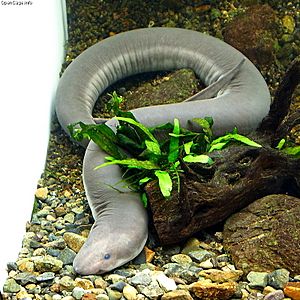Three-toed amphiuma facts for kids
Quick facts for kids Three-toed amphiuma |
|
|---|---|
 |
|
| Conservation status | |
| Scientific classification | |
| Synonyms | |
|
Syren quadrapeda Custis, 1807 |
Meet the three-toed amphiuma, also known by its scientific name, Amphiuma tridactylum. This cool creature is a type of salamander that lives in water. You can find it in the southeastern parts of the United States.
Contents
What Does a Three-Toed Amphiuma Look Like?
The three-toed amphiuma looks a lot like an eel. It has a long body that is dark gray, black, or brown. It also has tiny legs that are so small they are almost gone. These are called vestigial legs.
This salamander can get quite big! One was measured at over 41 inches (106 cm) long. But most adults are usually between 18 to 30 inches (45.7 to 76 cm) long. They have small eyes with no eyelids. They also have gill slits, which help them breathe underwater. Each of their four tiny legs has three toes. They also have about 62 grooves along their sides.
Where Do Three-Toed Amphiumas Live?
You can find the three-toed amphiuma in the United States. They live in states along the Gulf of Mexico, from Alabama to Texas. They also live north into Missouri, Arkansas, Tennessee, and Kentucky.
These salamanders often live in wet, low-lying areas. This includes marshes, lakes, and slow-moving streams. They also like cypress swamps. Sometimes, they even hide in burrows made by crayfish.
Behavior and Life Cycle
Three-toed amphiumas are active at night. They are also carnivores, meaning they eat other animals. They spend most of their time hiding in places with lots of plants. They prefer slow-moving water like swamps, ponds, and lakes.
They eat many different things. Their diet includes earthworms, fish, and crustaceans like crayfish. They also eat other small creatures without backbones. Fishermen sometimes catch them by accident. They don't like them much because amphiumas eat many fish.
Amphiumas mate from December to June. They then lay their eggs from April to October. Unlike some other amphiumas, they fertilize their eggs inside their bodies. A female can lay around 200 eggs. These eggs are laid in a single string that gets tangled in a hidden spot. They usually stay in the water. They only leave it rarely, usually after a big rainstorm.
Interesting Facts
The three-toed amphiuma has the largest red blood cells of any animal known! Their red blood cells measure about 70 by 40 micrometers.
Images for kids
-
Biofluorescence in a three-toed amphiuma



